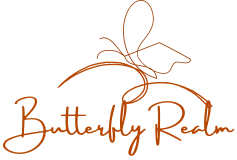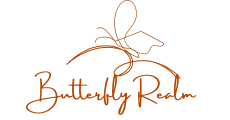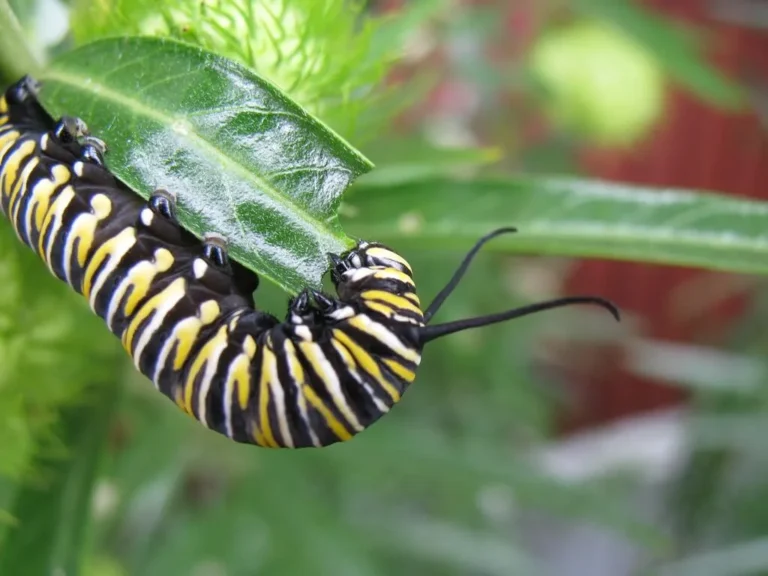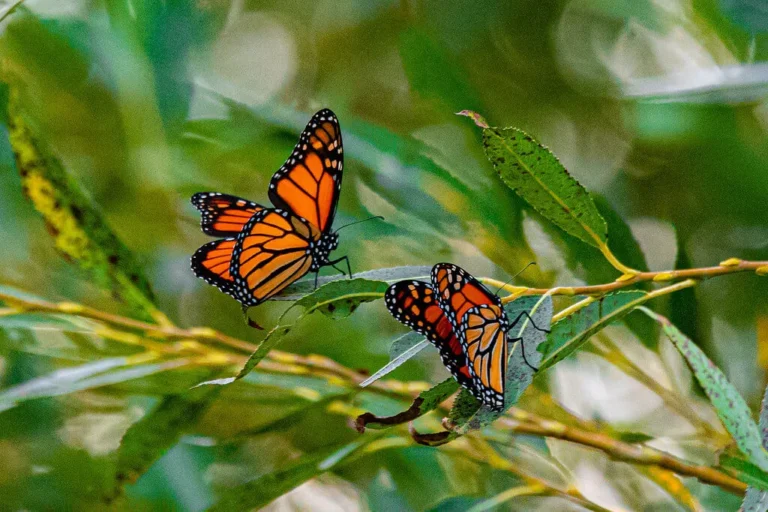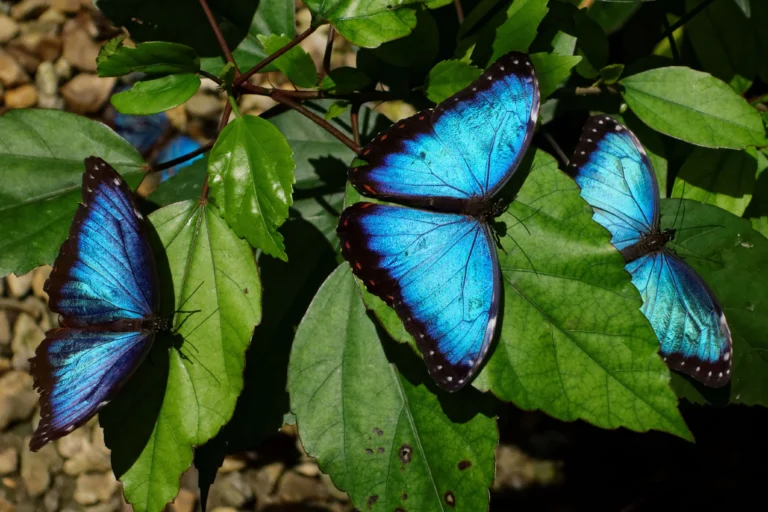10 Must-Have Monarch Butterfly Plants for a Thriving Ecosystem
An Overview of Ideal Plants: Monarch butterfly plants mainly include milkweed varieties and nectar plants. Popular milkweeds, like common, swamp, and butterfly weed, are crucial for egg-laying and feeding the caterpillars. As they mature into adults, monarch butterflies favor nectar plants like goldenrod and Joe-Pye weed. Incorporating these plants in your garden helps sustain the monarch population and enhances the beauty of your outdoor space.
Table of Contents
Introduction
Imagine having a garden that is not only beautiful but also plays a vital role in nature. A garden that hosts one of nature’s most spectacular visitors, the monarch butterfly.
These striking butterflies are a joy to witness, but they need our help to thrive. They depend heavily on certain plants during their lifecycle, making these plants an essential aspect of the ecosystem.
Monarch butterflies have a fascinating life journey. They go through several stages, transforming from tiny eggs to vibrant butterflies. This process is not only magical but also highly reliant on the plants they choose for their habitat.
Selecting the right monarch butterfly plant is not just a favor to these butterflies but a small yet significant step towards maintaining a balanced ecosystem.
These plants provide the nourishment and shelter necessary for monarchs at every stage of their life, ensuring their survival and the continuation of their mesmerizing lifecycle.
The Vital Role of Plants In Monarch Butterfly Migration
Monarch butterflies are seasoned travelers, migrating long distances to find the best habitats. These fascinating journeys are closely tied to the seasons and the specific plants that bloom during their travel.
Read our monarch butterfly migration guide for more info.
Let’s take a closer look at how certain plants act as life-savers for these migratory beauties.
Imagine a highway of flowers and plants, each one serving as a pit stop for the weary monarchs during their migration. These pit stops are essential, offering not only rest but also nourishment, helping them regain energy for the next leg of their journey.
Specific plants play a critical role in this migration process. They provide shelter and food, ensuring the butterflies can reach their destination safely.
By having a garden rich with flora that caters to the needs of monarch butterflies, you can play a part in safeguarding their migration routes, supporting a vibrant and necessary part of our ecosystem.
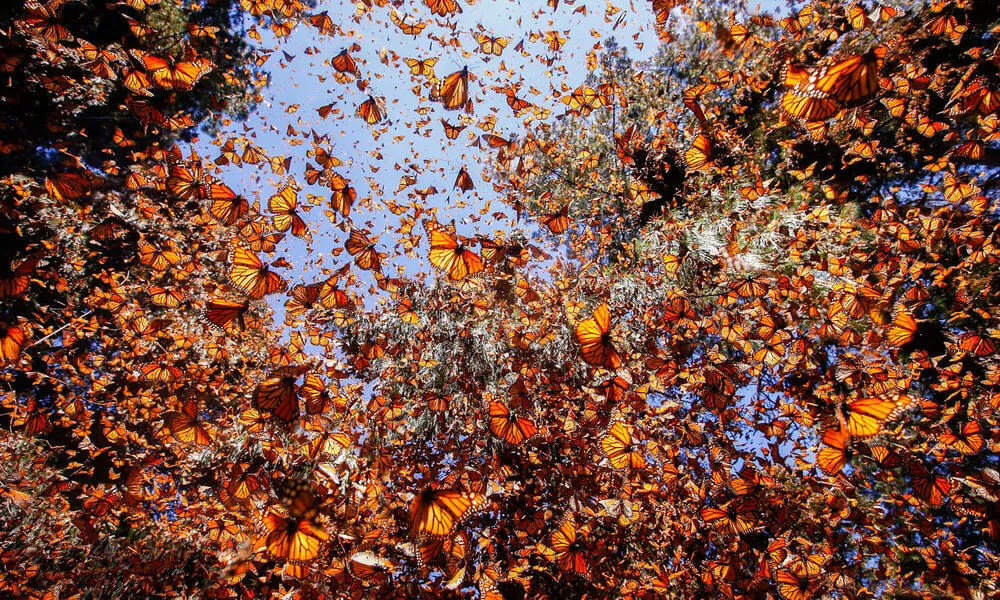
Monarch Butterfly Lifecycle: The Importance of Plant Choices
If you ever wondered about the secret behind the monarch butterfly’s stunning transformation, the answer lies in their close bond with certain plants. Let’s walk through each stage of their life, understanding how vital plants are at every step.
Egg Stage
In the very beginning, female monarch butterflies lay their tiny eggs on milkweed plants. This isn’t a random choice; milkweed plants offer the perfect nutrients and protection for the eggs, setting the stage for a healthy start to their life.
Larva Stage
As the eggs hatch, tiny caterpillars emerge with an insatiable appetite. Their favorite meal? The leaves of the milkweed plant. This stage is all about growth, and the milkweed plants provide all the nourishment these growing caterpillars need.
Discover more about this phenomenon in our article: “How Milkweed Plants Make Monarch Butterflies Poisonous“.
Pupa Stage
When it’s time to transform, the caterpillars find a quiet and safe spot amidst the vegetation. The surrounding plants act as a protective shield, offering safety and the right environment for the miraculous transformation to take place.
Learn more about this stage in our monarch butterfly chrysalis stage guide.
Adult Stage
Once transformed into gorgeous butterflies, their love for plants doesn’t stop. Now, they seek nectar plants to feed on. These plants not only offer food but also play a crucial role during the reproduction and migration phases, offering sustenance for both activities.
Discover more about what monarch butterflies eat here.
Understanding the deep connection between the monarch butterfly and specific plants gives us insight into the magic and beauty of nature, highlighting the intricate bond that exists within the ecosystem.
Why Monarch Butterfly Plants are Essential
Monarch butterflies and plants share a beautiful friendship that benefits both parties and the environment as a whole. Let’s explore the vital roles that these special plants play.
Role in Sustaining the Monarch Population
Monarch butterflies depend heavily on specific plants for their survival. These plants are like nurturing homes, offering everything from food to protection. In turn, this helps in maintaining a healthy monarch population, allowing us to witness their mesmerizing presence year after year.
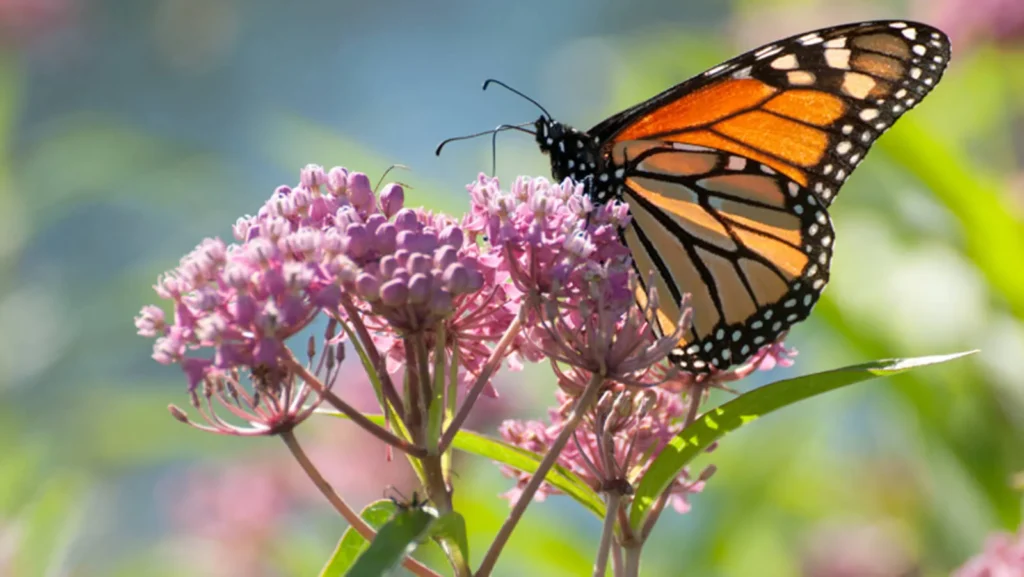
Role in the Ecosystem
The bond between monarch butterflies and their favorite plants goes beyond their lifecycle. It’s a connection that nourishes the soil, encourages pollination, and helps in maintaining a balanced ecosystem.
By choosing to grow these plants, you are fostering a richer, more diverse environment.
Benefits of Gardening and Agriculture
Monarch butterfly plants aren’t just good for the butterflies; they are great for gardens too! Incorporating these plants can enhance the beauty of your garden, attract other beneficial insects, and even help keep pest populations under control.
It’s a win-win for both nature and garden enthusiasts.
Understanding the significant roles that monarch butterfly plants play can inspire us to make thoughtful choices in our gardens, creating spaces that nurture both beauty and biodiversity.
The Best Plants for Monarch Butterflies
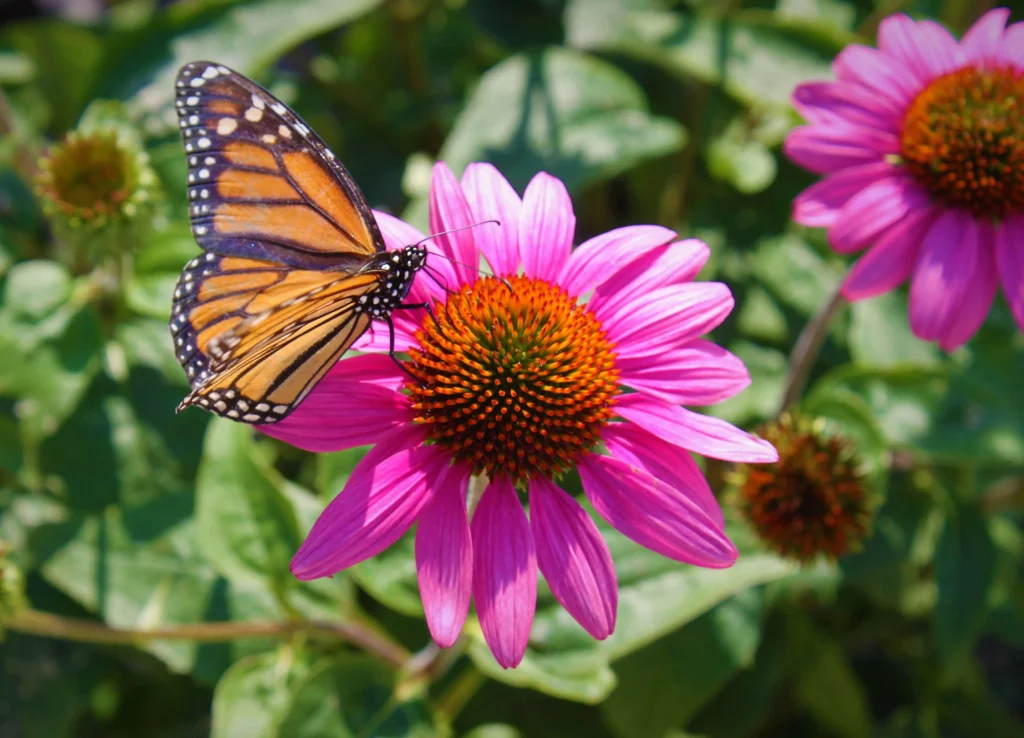
Choosing the right plants is like setting up a banquet for the monarch butterflies. Let’s discover some of the top choices that can make your garden a haven for these beautiful creatures.
Milkweed Varieties
Milkweed is the superstar in a monarch butterfly garden. Let’s look at some popular varieties that are sure to attract these butterflies:
- Common Milkweed: This plant is a favorite for monarch butterflies to lay their eggs. It’s easy to grow and provides ample space for the caterpillars to feed and grow.
- Swamp Milkweed: A plant that loves wet areas, it’s an excellent choice for damp spots in your garden. It not only attracts monarchs but also adds a splash of color with its beautiful pink flowers.
- Butterfly Weed: Despite its name, this is a type of milkweed. It blooms with vibrant orange flowers, providing a rich source of nectar and adding a bright hue to your garden.
Additional Varieties:
- Whorled Milkweed: This variety is slender and tall, with delicate clusters of white flowers, serving as another excellent option for your butterfly garden.
- Tropical Milkweed: With bright red and yellow flowers, this variety is not only a butterfly magnet but also adds a vibrant touch to your garden.
Nectar Plants
Besides milkweed, monarch butterflies love to feast on the nectar of various flowers. Here are some plants that can provide a delicious meal for them:
- Goldenrod: This plant stands tall with its bright yellow flowers, offering a rich source of nectar during the late summer and fall, a crucial time for migrating monarchs.
- Joe-Pye Weed: A tall plant with pink blossoms, it’s a favorite among butterflies, including the monarchs. It’s a great addition to add some height and color to your garden.
- Purple Coneflower: This plant is not only lovely to look at but also a rich source of nectar. Its vibrant purple petals can add a touch of beauty to your garden while feeding the visiting monarchs.
Additional Options:
- Zinnias: These are easy-to-grow flowers that offer a rich source of nectar, available in a range of bright colors to beautify your garden.
- Sunflowers: These iconic flowers are not only visually striking but also provide a rich nectar source for monarchs and other butterflies.
Creating a Monarch Butterfly Garden
Transforming your garden into a sanctuary for monarch butterflies is a rewarding journey. Here, we share a simple guide to help you set up a monarch butterfly garden from scratch.
Selection of Monarch Butterfly Plants
First things first, selecting the right plants is key. Opt for a mixture of milkweed varieties for the caterpillars and nectar plants for the adult butterflies. Ensure that you choose plants that thrive in your local climate to create a sustainable habitat.
Designing the Garden: Tips and Ideas
Now comes the fun part, designing the garden. Arrange the plants in clusters to create a more substantial visual and scent impact, attracting more butterflies.
Incorporate different heights and colors to create a garden that’s not only butterfly-friendly but also aesthetically pleasing.
Maintenance and Care
Creating a butterfly garden is not a set-it-and-forget-it project. Regular maintenance is essential to ensure that the plants remain healthy and continue to support the monarch butterfly population.
Simple practices like mulching, regular watering, and avoiding pesticides can go a long way in maintaining a thriving garden.
In the journey of creating a butterfly garden, every step you take is a gift to nature, fostering a space where life blooms in its most beautiful forms.
Conclusion
So, we have journeyed through the wonderful world of monarch butterflies and the plants that nurture them at every step. From understanding their lifecycle to setting up a garden that welcomes them, we have covered a lot of ground.
But why stop here? You have the power to make a difference, to create a haven where these magnificent creatures can flourish. Whether it’s planting a single milkweed or designing an entire garden, every effort counts.
Now, we encourage you to take the next step. Get your gardening gloves ready, pick out your favorite plants, and start creating a space that echoes with the flutter of monarch wings.
It’s not just a garden; it’s a step towards nurturing nature, one butterfly at a time.
Frequently Asked Questions
Why are monarch butterfly plants important?
Monarch butterfly plants, particularly milkweeds, are vital as they are the primary food source for monarch caterpillars. These plants also provide nectar to adult monarchs and other pollinators, fostering a vibrant and diverse ecosystem.
How can I attract monarch butterflies to my garden?
To attract monarch butterflies, plant a variety of milkweeds and nectar plants in your garden. Ensure to have a blend of colors and heights to create an inviting habitat.
Also, avoid using pesticides as they can harm the butterflies and other beneficial insects.
What time of the year is best for starting a monarch butterfly garden?
The best time to start a monarch butterfly garden is in the spring. This gives the plants time to establish themselves before the monarch butterflies arrive in the summer.
However, you can start planning and preparing your garden in the late winter or early spring.
Can I create a monarch butterfly garden in a small space?
Yes, you can create a monarch butterfly garden even in a small space. Focus on selecting a few varieties of milkweeds and nectar plants that are well-suited to your climate and space.
Even a small balcony or patio can be transformed into a butterfly haven with the right selection of plants.
What is the best plant for monarch butterflies?
The best plant for monarch butterflies is undoubtedly the milkweed. In particular, the common milkweed (Asclepias syriaca) stands out as a favorite.
It serves a dual purpose in the life cycle of the monarch butterfly: it is a place where they lay their eggs and also the primary food source for the caterpillars once they hatch.
Growing these plants in your garden will not only attract monarch butterflies but also offer them a nurturing habitat.
The common milkweed sports globular clusters of pink flowers that add a touch of beauty to your garden, making it a visually pleasing choice as well.
It’s a win-win plant that promotes the well-being of monarch butterflies while enhancing the aesthetics of your garden.
